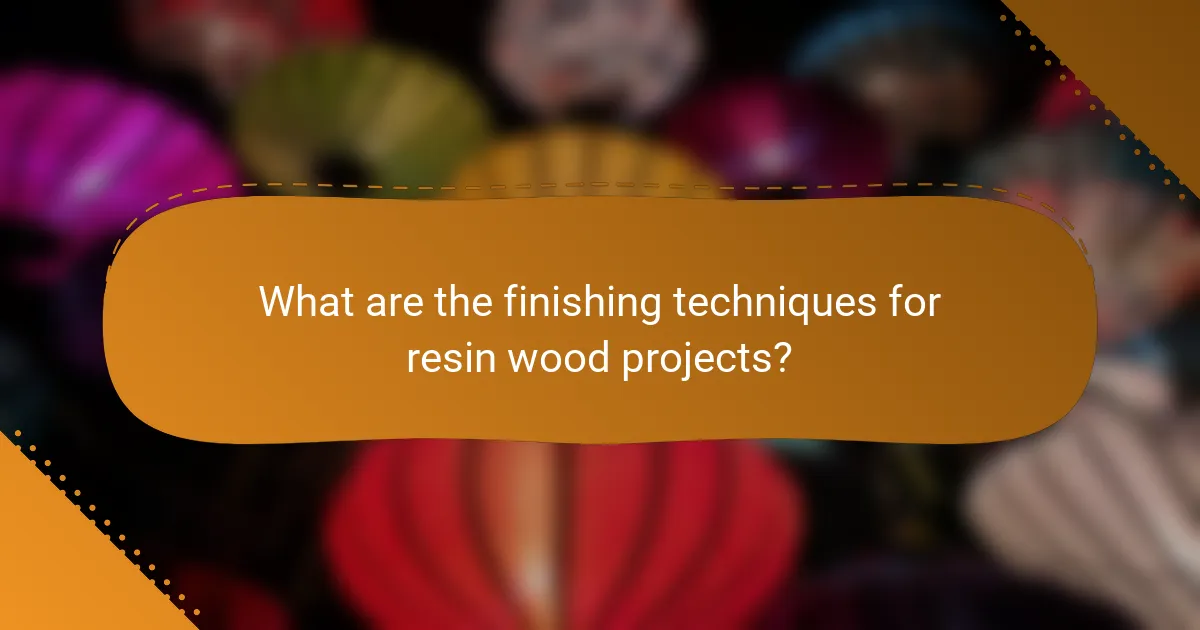Woodworking and resin techniques offer beginners a creative way to craft unique pieces by combining the natural beauty of wood with the versatility of resin. By understanding the basics of both mediums, you can create stunning projects like resin river tables and coasters, enhancing your woodworking skills. Mastering the mixing and pouring of resin is essential for achieving a flawless finish, allowing you to explore endless design possibilities.

How to start woodworking with resin techniques?
To start woodworking with resin techniques, focus on understanding the basics of both woodworking and resin application. Combining these methods allows you to create unique pieces, such as tables or art, by embedding resin in wood or using it as a finish.
Basic tools for beginners
Essential tools for beginners include a saw, sander, drill, and clamps. A jigsaw or circular saw will help cut wood to size, while a random orbital sander smooths surfaces. Clamps are crucial for holding pieces together while the resin cures.
Investing in a good quality mixing stick and measuring cups for the resin is also important. These tools ensure accurate mixing ratios, which is vital for achieving the desired results.
Essential materials for resin projects
For resin projects, you will need epoxy resin, hardener, and wood. Choose a high-quality epoxy resin that is suitable for your project type, as different resins have varying properties. Additionally, consider using pigments or dyes to add color to your resin.
Wood selection is also key; hardwoods like oak or walnut work well for embedding resin. Make sure the wood is dry and free from moisture to prevent issues during the curing process.
Safety precautions when using resin
When working with resin, always wear protective gear, including gloves, goggles, and a mask. Resin can emit harmful fumes, so ensure your workspace is well-ventilated. Using a respirator is advisable if working with larger quantities of resin.
Be cautious with spills; resin can be difficult to clean once cured. Keep your workspace organized and have a plan for managing any accidents. Following these safety precautions will help you work confidently and effectively with resin.

What are the best woodworking projects using resin?
The best woodworking projects using resin include resin river tables, coasters, and unique art pieces. These projects allow beginners to explore the creative possibilities of combining wood and resin, resulting in stunning and functional items.
Resin river tables
Resin river tables are a popular choice for woodworking enthusiasts. They feature a wooden slab with a river-like channel filled with colored resin, creating a striking visual effect. When selecting wood, consider species like walnut or oak, which pair beautifully with resin.
To create a resin river table, start by preparing the wood slab and building a mold to contain the resin. Mixing the resin according to the manufacturer’s instructions is crucial, as improper ratios can lead to curing issues. Allow ample time for the resin to cure fully before sanding and finishing the table.
Resin coasters
Resin coasters are simple yet effective projects for beginners. They can be made using small wooden bases and poured resin, allowing for endless customization with colors and inclusions like dried flowers or glitter. This project is ideal for practicing resin pouring techniques.
To make resin coasters, cut wood into uniform circles or squares and seal the edges to prevent resin leakage. Mix the resin and pour it over the wood, ensuring an even layer. After curing, sand the edges for a smooth finish and apply a sealant if desired.
Resin art pieces
Creating resin art pieces offers a creative outlet for beginners. These can range from abstract designs to functional items like wall art or decorative bowls. The versatility of resin allows for experimentation with colors, textures, and layering techniques.
When making resin art, use a clean, flat surface and protective gear. Experiment with different pouring techniques, such as swirls or layers, to achieve unique effects. Always follow safety guidelines and work in a well-ventilated area, as resin fumes can be harmful.

How to mix and pour resin for woodworking?
Mixing and pouring resin for woodworking involves combining epoxy resin with a hardener in the correct proportions, then applying it to your wood project. Proper mixing and pouring techniques ensure a smooth finish and prevent issues like bubbles or uneven curing.
Mixing ratios for epoxy resin
The typical mixing ratio for epoxy resin is often 1:1 or 2:1, resin to hardener, depending on the product specifications. Always check the manufacturer’s guidelines for the specific brand you are using, as ratios can vary significantly.
For example, if you are using a 2:1 epoxy, you would mix two parts resin with one part hardener. Accurate measurement is crucial; using a digital scale can help achieve the right proportions.
Pouring techniques for even distribution
To ensure even distribution of resin, pour it slowly and steadily into the center of the area you are filling. This technique helps minimize the formation of air bubbles and allows the resin to flow naturally to the edges.
Consider using a heat gun or torch to gently warm the resin after pouring, which can help release trapped air bubbles. Always work in a well-ventilated area and wear appropriate safety gear.
Common mistakes to avoid
A frequent mistake when mixing resin is not measuring the components accurately, which can lead to improper curing. Always use precise measuring tools and follow the recommended ratios closely.
Another common pitfall is pouring too quickly, which can trap air bubbles. Take your time and pour in layers if necessary, allowing each layer to cure before adding more resin for thicker applications.

What are the finishing techniques for resin wood projects?
Finishing techniques for resin wood projects enhance the aesthetic appeal and durability of the final product. Key methods include sanding and polishing, as well as applying sealants and finishes to protect the surface and improve its appearance.
Sanding and polishing methods
Sanding is crucial for achieving a smooth surface on resin wood projects. Start with a coarse grit sandpaper, such as 80 or 120, to remove any imperfections, then gradually move to finer grits, like 220 or 400, for a polished finish. Wet sanding can also be beneficial, as it reduces dust and helps achieve a glass-like surface.
Polishing can be done using a buffing wheel or a soft cloth with polishing compound. This step enhances the shine and clarity of the resin. Be cautious not to overheat the resin during polishing, as excessive heat can cause damage or cloudiness.
Applying sealants and finishes
Applying sealants and finishes protects resin wood projects from moisture and UV damage. Common options include polyurethane, epoxy, or specialized resin finishes. Ensure the surface is clean and dry before application to achieve optimal adhesion.
When selecting a sealant, consider the intended use of the project. For outdoor items, choose a UV-resistant finish to prevent fading. For indoor projects, a water-based polyurethane can provide a durable and clear coat. Always follow the manufacturer’s instructions for application and curing times to ensure the best results.

How to choose the right resin for woodworking?
Choosing the right resin for woodworking involves understanding the specific needs of your project, including durability, clarity, and ease of use. Epoxy and polyurethane are the most common types, each offering unique benefits and considerations.
Types of resin suitable for wood projects
Two primary types of resin suitable for woodworking are epoxy resin and polyurethane resin. Epoxy resin is known for its strong adhesion and excellent clarity, making it ideal for filling gaps and creating a glass-like finish. Polyurethane resin, on the other hand, is more flexible and resistant to UV light, which can be beneficial for outdoor projects.
When selecting a resin, consider the specific application. For instance, if you are embedding objects in wood or creating river tables, epoxy is often preferred due to its thickness and clarity. For coatings and finishes, polyurethane may be more suitable due to its durability and resistance to scratches.
Comparing epoxy and polyurethane resins
Epoxy and polyurethane resins differ significantly in their properties and applications. Epoxy typically cures harder and is less flexible, making it great for structural applications. However, it can be more challenging to work with due to longer curing times and the need for precise mixing ratios.
Polyurethane resins cure faster and are easier to apply, but they may not provide the same level of hardness as epoxy. They are also more prone to yellowing over time when exposed to sunlight. For projects that require a clear finish and high durability, epoxy is often the better choice, while polyurethane is suitable for quick applications and flexibility.

What are the costs associated with woodworking and resin projects?
The costs for woodworking and resin projects can vary significantly based on the tools, materials, and techniques you choose. Beginners should expect to invest in both quality tools and resin products, with total expenses ranging from a few hundred to over a thousand dollars depending on the complexity of the projects.
Budgeting for tools and materials
When budgeting for woodworking and resin projects, consider the essential tools such as saws, drills, and clamps, alongside resin-specific items like mixing cups and safety gear. A basic woodworking toolkit can cost between $100 and $500, while resin materials might add another $50 to $200 for a starter kit.
It’s wise to prioritize quality over quantity; investing in durable tools can save money in the long run. Look for second-hand options or starter kits that include multiple tools at a discounted price.
Cost analysis of resin types
Resin types can significantly impact your project costs. Epoxy resin, commonly used for woodworking, typically ranges from $30 to $150 per gallon, depending on the brand and quality. Cheaper alternatives like polyester resin may be available but often lack the clarity and durability of epoxy.
When selecting resin, consider factors such as curing time, UV resistance, and intended use. For instance, if you’re creating a tabletop, investing in a high-quality epoxy will yield better results than opting for a lower-cost option.

Where to find inspiration for woodworking and resin projects?
Inspiration for woodworking and resin projects can be found in various places, including online platforms, local workshops, and nature. Exploring these sources will help you discover unique ideas and techniques to enhance your skills.
Online platforms
Websites like Pinterest, Instagram, and YouTube are treasure troves for woodworking and resin project inspiration. You can find countless tutorials, project showcases, and step-by-step guides that cater to different skill levels. Engaging with communities on these platforms allows you to exchange ideas and receive feedback.
Consider following specific hashtags related to woodworking and resin art, such as #ResinArt or #WoodworkingProjects, to streamline your search. This will help you stay updated on trends and innovative techniques.
Local workshops and classes
Participating in local workshops or classes can provide hands-on experience and direct inspiration. Many community centers, craft stores, and woodworking clubs offer sessions where you can learn from experienced artisans. This environment fosters creativity and allows you to see different approaches to combining wood and resin.
Look for classes that focus on specific techniques, such as epoxy pouring or wood finishing, to gain practical skills while sparking new project ideas.
Nature and everyday objects
Nature is an abundant source of inspiration for woodworking and resin projects. Observing the colors, textures, and patterns found in wood grains and natural elements can lead to unique design concepts. For instance, incorporating leaves, flowers, or stones into resin can create stunning effects.
Additionally, everyday objects around your home can inspire new projects. Consider repurposing old furniture or using found materials to create functional art pieces. This approach not only sparks creativity but also promotes sustainability.


